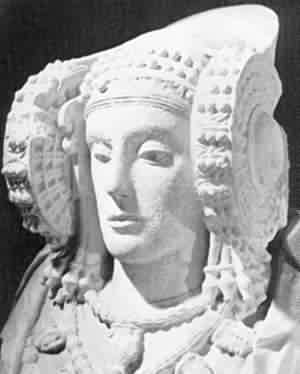
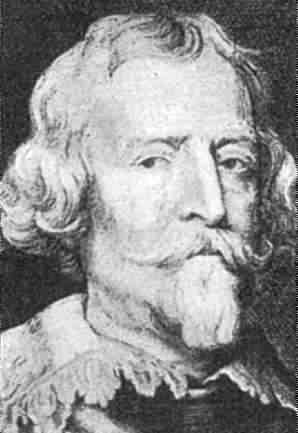
MARCH OF THE TITANS - A HISTORY OF THE WHITE RACE
CHAPTER 22 : LESSONS IN DECLINE -
SPAIN AND PORTUGAL - Part I
Spain and Portugal are two countries in western Europe which have both been marked by phases of great wealth and power and then decline - the classic characteristics of the rise and fall of civilizations.
Bearing in mind the lessons already plain from the ancient civilizations, it is therefore easy to look for the population shifts which as always, closely track the rise and fall of all civilizations which have declined.
As to be expected, with both Spain and Portugal, the population changes are also evident - and are also directly linked to the leading and then reduced roles these nations have played in not only White history, but also of world history.
SPAIN
FIRST INHABITANTS
The first inhabitants of the Iberian peninsula were the Old European peoples, who established a Neolithic, or farming culture in the region.
The next people to enter the Iberian peninsula after it had been settled by the Neolithic Old Europeans were the Semitic/Indo-European /Old European mix known as the Phoenicians, who had established trading posts on the southern coast of Spain prior to 1000 BC, working from their base in the city they founded in North Africa, Carthage. The Spanish towns of Cadiz, Malaga and Cordoba all date from this time.
Then the first pure Indo-Europeans arrived around 600 BC, when the Classical Greeks established colonies in the north eastern part of Spain. They later expanded southwards down into the modern day town of Valencia.
CELTS ARRIVE - CIRCA 500 BC
Around 500 BC, Indo-European invaders from central Europe, the Celts, first crossed the Pyrenees mountains and settled in the western and northern parts of Spain. Later other groups of Celts overran even larger areas of Spain. All of this time the new arrivals had been slowly intermarrying with the original populations they had found.
Subsequently a number of these people - mixtures of Celts, Greeks, Old Europeans and Phoenicians, moved north into southern France, forming today what is known as Gascony.


Evidence of the Gothic Nordics in Spain: Two fine examples of extreme Nordic racial types which made up the population of the Iberian peninsula after the second great Indo-European invasion of that territory. Left: The famous 'Lady of the Elche' circa 400 BC, Madrid; and right, Count Colonna, a Spanish general. (Engraving by Van Dyck).
One of the original Old European peoples to have remained largely unaffected by the racial comings and goings were the Basques in the north. Surrounded by mountains, the Basques avoided the integration process and their language represents one of the few surviving examples of the original Old European tongue. The Basques also retain to a certain degree the "dark" racial look of the Old European population.
CARTHAGE OCCUPIES CADIZ AND FOUNDS BARCELONA
In 480 BC, an army from the originally Phoenician founded city of Carthage in North Africa (Tunisia) was sent to help put down a local uprising in the town of Cadiz, a city which had retained close links with Carthage from the earliest times. The Carthaginian army never left Cadiz, and went on to establish Carthaginian control over large parts of Spain.
After the first Punic War between Rome and Carthage in 237 BC, the Carthaginians strengthened their bases in Spain, founding the cities of Cartagena and Barcelona. The Nordic Carthaginian general Hannibal used Spain as a jumping off place for his great invasion of Italy. The ultimate defeat of Carthage at the end of the Punic Wars saw all the Carthaginian colonies in Spain surrendered to Roman rule. It took 75 years for the Romans to finally establish strict control over all the Iberians, but after that they were to remain masters of Spain for the next five centuries. During this time the Romans were to create many of their long lasting architectural structures - the magnificent aqueduct at Segovia, which after 1,800 years still carries that town's water supplies, is a prime example.
SEPHARDIC JEWS
Spain, like many other areas in the Mediterranean Roman Empire, lay open to immigration from other parts of the Middle East, and after the Diaspora of the Jews in AD 70, many Jews fleeing along the North African coast crossed the Straits of Gilbratar into Spain, becoming an established minority in that country. These were the Sephardim, or Sephardic Jews. As with Jewish communities everywhere, anti-Semitism followed them, with Spain being no exception.
NEW INDO-EUROPEAN INVASIONS - ALANS AND VANDALS
Roman rule in Spain was only ended in 409 AD when bands of Germanics: the Alans, the Vandals, the Suebians and others, crossed the Pyrenees and overthrew the Romanized Spaniards, setting up their own kingdoms.
These Indo-European invaders were followed in quick order by an invasion of Visigoths under their leader Adolf (brother in law of Alaric, the Goth who had sacked Rome in 410 AD). The Visigoths quickly routed everyone in Spain, and established an empire in that country which included a portion of southern France as well. The first Visigoth capital was established in the modern French town of Toulouse.
Although the Visigoths had subdued the Vandals and Suebians, relations between the latter two groups preceded to worsen over a number of domestic issues, and the two tribes went to war with each other around 420 AD.
The Vandals then started moving south, giving their name to the region known as Andalusia (from Vandalusia) and finally, in 429 AD, an 80,000 strong contingent of Vandals crossed the straits of Gilbratar and seized the old Roman province of Africa (Tunisia and parts of Algeria - the old Carthaginian state).
VISIGOTH KINGDOM
The Visigoths, who were later to be strengthened by the arrival of the remnants of the Ostrogoths (who had been decimated by the advancing Huns) then reasserted their dominance in Spain, and set up a formal Gothic Christian kingdom in Spain which lasted from around 460 AD to 711 AD. The first Spanish Gothic king was Euric - son of Theodoric, one of Atilla the Hun's great adversaries.
MIXED MARRIAGES PROHIBITED - GOTHIC LAW
One of the first laws which the Gothic kingdom in Spain established was a ban on all mixed marriages. Goths were only allowed to marry Goths, and punishment for violating this ban was burning at the stake.
This overtly racial law kept the intermixing of Goths with all others to an absolute minimum - and particularly with the growing Jewish population.
Gothic Spain settled down into a period of relative peace and resultant prosperity, with the only discordant note being sounded by the large Jewish population.
Partly because of a fanatic Christianizing zeal (which was common to all early Christians), partly because of Jewish domination of the Spanish financial world, and partly because of the exclusivity and separation which the Jewish religion gave to the Jews, ill feeling between the Christian Goths and Jews in Spain reached a height which had not been seen since the time of the Roman Jewish war of 550 years previously.
CONVERSOS - JEWS FORCED TO BAPTISM
In 620 AD, the Spanish Gothic king, Sisbert, ordered 80,000 Jews to be baptized as Christians in an attempt to break Judaism in Spain. This was the start of the Conversos - Spanish Jews who publicly espoused Christianity but in secret kept up Jewish traditions. They were also known by the less complimentary name of Marranos - "pigs".
Although the 80,000 Jews baptized by Sisbert remained in Spain, about an equal number left Spain for other parts of Europe to escape the growing anti-Semitic feeling in Iberia. Their departure was not a moment too soon - 53 years later, in 673 AD, another Spanish Gothic king, Wamba, formally expelled all Jews from Spain who would not convert to Christianity.
Wamba's immediate predecessor, King Recesuinto, had taken a step which was to have far reaching consequences - he abolished the long standing ban on mixed marriages, replacing it with a law stating that anyone of Christian beliefs was allowed to marry anyone else of similar beliefs. Henceforth the only ban on intermarriage would be on religious grounds, not racial.
This step allowed any person of any racial origin, as long as they professed Christianity, to intermarry and mix with the Goths. In this way the first steps were taken that would lead towards the dissolution of the Gothic tribe in Spain.
NONWHITE MUSLIMS INVADE SPAIN - 711 AD
In 711 AD, the Nonwhite Muslim invasion finally reached Spain, having swept up out of the Saudi-Arabian peninsula, conquered Egypt, Libya, Tunisia and North Africa to the Gilbratar Strait.
Launching a ferocious assault across the narrow strait, the Muslims defeated the Gothic kingdom in stages and managed to establish what became known as Moorish rule over the greatest part of Spain and Portugal, with only the very northern parts remaining in Gothic hands.
RECONQUEST - 700 YEARS LATER
The period of reconquest of Spain by the White Goths made up yet another great race war in Europe, a duel fought to the death which finally ended in 1492 AD when the last Moorish citadel, Granada in the south, surrendered to the White armies. (The full story and implications of the Moor/White race war in Spain is told in a following chapter). The reconquest of Spain from the Moors was ended with a general expulsion of all Jews who had not converted to Catholicism.
The prominent position held by many Jews in the Moorish administration of occupied Spain and their record of collaboration with the Moors was a significant factor in inciting anti-Jewish feeling of the time.
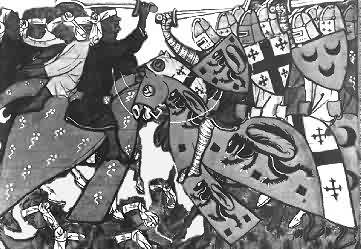
Muslim cavalry come face to face with White knights in this illustration from a manuscript dating from 1337. Lightly armed Muslims such as these were no match for the heavily armored White soldiers, although clashes were by no means as uneven as this picture suggests. Ultimately the Whites in Spain gained the upper hand over the Muslim invaders, although it took 700 years to drive the last Islamic invader off the European continent.
EXPULSION OF 250,000 MIXED RACE PEOPLES BY PHILIP II
The Moors had occupied Spain for over 700 years, so it was inevitable that they would have mixed with the local population over whom they ruled.
In this way a not insignificant amount of Moorish - in reality mixed race Arabic/Black - blood entered a few Spanish families in the southernmost parts of Spain and Portugal.
The Gothic Spaniards did however recognize this as an issue, and in 1609, the Spanish king, Philip III, ordered the physical expulsion of some 250,000 "Moriscos" or Christianized Moors from the country, purely on the basis of their race and not their religion - a marked difference to the earlier expulsion of the Jews, who, if genuinely converted to Catholicism, were allowed to stay.
The vast majority of these Christianized Moors were in reality of mixed race - part Moorish, part White Spanish (hence their adherence to Christianity).
This remarkable example of the expulsion on racial grounds was a major reason why the infusion of Moorish blood into Spain was not as significant as it could have been, and thus played only a minor contributing role in the creation of the dark looks for which some Spaniards are still known today.
SPANISH INQUISITION AND FINAL EXPULSION OF THE JEWS
In 1478 AD, the Spanish king and queen, Ferdinand and Isabella, launched what became famous throughout the world as the Spanish Inquisition - in theory an attempt to enforce religious uniformity, but in reality a political tool through which the Spanish tried to drive out the last of the Conversos, making it into a primarily anti-Jewish campaign.
However, all sorts of "heretics" - people who disputed the Catholic version of Christianity, were also persecuted, with approximately 2,000 people being burned at the stake during the time of the Inquisition.
Finally in 1492 AD, the Spanish expelled all the Jews from Spain who had still not converted to Christianity.
SPAIN'S GOLDEN AGE - RULED BY "BLUE BLOOD"
Although a certain amount of mixing with the Moors in Southern Spain had taken place, by the time of the expulsion of the last Moors from Spain, the majority of Whites had not mixed with the Muslim invaders, and remained true to their Gothic lineage, absorbing only a number of Sephardic Jews who had truly converted to Catholicism.
The very expression "blue blood" comes from Spain of this time - the ruling Visigoth nobles had such white skins that the blue arteries were visible on their faces, creating the expression of blue blood and its link to nobility which has lasted to this day.
A series of calculated steps were then taken by the re-established and vigorous Gothic kingdom which led directly to the Golden Age of Spain. The Spanish word for gentleman, hildago, in fact means literally the "son of the Goth" and the great Spanish rulers Ferdinand and Isabella, who led the liberation from Moorish rule, were both red headed Goths.
THE AMERICAS
In 1492, the Lombard Germanic Christopher Columbus succeeded in persuading the Spanish royalty that the earth was indeed round (as had been predicted by the ancient Indo-European Greeks and reconfirmed by the Roman-Greek astronomers at Alexandria around the year 200 BC) and that he could sail to the then newly discovered continent of India by sailing west instead of east, as the other European nations were doing.
Financed by the Spanish court, Columbus sailed west, discovering not a new path to India but instead finding Central America. So convinced was he that he had in fact found India, that the native peoples discovered in the Americas were even called Indians, a name which has stuck to this day.
Columbus' voyages were followed by Spain's expansion into the Americas and by the 1550s Spain controlled most of South America, Central America, Florida, Cuba, and, in Asia, the Philippine Islands. This empire brought enormous wealth to Spain, and it became a major power in Europe.
THE SPANISH EMPIRE GROWS
By 1516, through a series of royal family connections and outright conquest, Spain controlled southern Italy, the Netherlands and Burgundy in France, with the Spanish king being elected "Holy Roman emperor" by the Pope, an attempt by the Catholic Church to cast itself as the successor to the Classical Roman Empire.
In 1580, the King of Portugal died and the Spanish and Portuguese thrones were united due to a family connection. Portuguese resentment was placated by a number of self rule concessions. The addition of Portugal to Spain meant not only the acquisition of the Portuguese colonial possessions, but also of the vast numbers of Black slaves that Portugal was dealing in, both at home and abroad.
The addition of the Portuguese colonial possession to Spain's already substantial colonies created that was the largest empire in the world at the time.
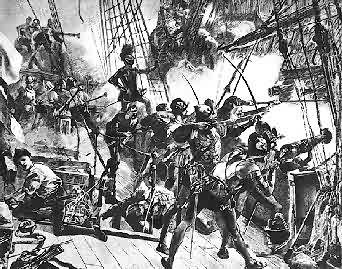
Action stations aboard a Spanish warship during the eventful battle off the English coast in 1588 which saw a large invasion fleet defeated by the English navy after an epic three day engagement. Note the close quarters of the fighting and the early Spanish cannon.
EUROPEAN WARS
The spread of the Protestant rebellion amongst Christians in Spain led the still heavily pro-Catholic state to start persecuting these new "heretics" as well. This, combined with the attempts to hold onto the Protestant Netherlands led directly to war with newly Protestant England, which ultimately led in turn to the famous Thirty Years War, which was followed by war with France in 1635.
The Spanish armada, a great fleet sent to conquer the English, was dramatically defeated by superior British organization. It was a defeat, which, combined with the effects of the colonial policy and the demographic shift in Spain itself, from which the once mighty Goths were not to recover.
COLONIAL POLICY AND THE IMPORTATION OF BLACK SLAVES - IN EXCESS OF 1 MILLION
Spanish colonial policy was different from colonial policies being pursued by other White nations in Europe (with the exception of Portugal, which followed the Spanish example).
Instead of colonizing their acquisitions with millions of their own people, the Spanish used their colonial possessions purely as economic resources. Spanish men who went to South America, the Caribbean or even North America, did not take families or Spanish women with them.
The result was a massive degree of mixing with the local populations in the Spanish colonies, producing an overwhelmingly mixed race population still prevalent in Central and Southern America.
In addition to this, the Spaniards, like most other European nations, became users of Black slaves in its colonies - millions of Blacks were imported to South and Central America, adding a further dimension to the racial mix in those territories.
However, also in common with Portugal and again differing with the other European nations, a huge number of Black slaves were imported into Spain itself.
Although it has never been established what were the exact numbers of Black slaves imported into Spain, the figure was certainly in excess of one million. Almost all of these Blacks from deepest Africa were then absorbed into Spain, significantly altering vast numbers of the Spanish population.
GYPSIES - SPAIN'S FIVE CENTURIES LONG IMMIGRATION INVASION
As if the Black slaves and Moorish occupation was not enough, Spain's racial character has also been significantly affected by a five century long immigration of Gypsies, dark wandering nomads who had their origin in India itself. The Gypsies spread throughout Europe but concentrated in Spain and Romania, where their numbers are in the millions.
In Spain, the Gypsies occupied large areas to the point where significant parts of what is thought of as Spanish culture - for example the "Flamenco" dance - is in fact Gypsy in origin. In this way, much of what is regarded as Spanish is actually Gypsy, and it can be argued with a fair degree of certainty that the Gypsy element in Spain's current mixed race population is very high - possibly even a majority, given that the Spaniards expelled both Moors and other mixed race elements during that country’s history.
The official 1992 estimate of the number of Gypsies in Spain was around 600,000 - like all official figures, it is most likely an underestimation and does not include the vast number of mixed race Spanish/Gypsy people who display the classic "dark" appearance so incorrectly associated with true Spaniards.
It would however be incorrect to class every single Spaniard with this same brush - many Spaniards did not mix with either the Moors, Black slaves or the Gypsies. These people remained strongest in the north of Spain.

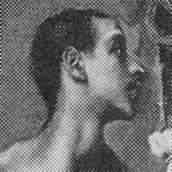
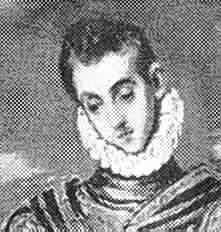
Spain: the racial divisions emerge. This famous painting by El Greco, (1548 -1614), "Saint Martin and the Beggar", is a vivid depiction of the emerging division of Spain into those who had mixed with the Nonwhite Muslims and those who had not. Saint Martin is portrayed as completely White: the beggar is clearly of mixed race. Insets compare the faces of the two characters in this painting.
SPAIN'S DECLINE AS A GREAT POWER FOLLOWS MISCEGENATION
The change in the racial face of Spain, combined with its disastrous European wars, brought about that country's decline as a great power, perfectly in line with the law that societies create cultures in the image of their populations, and change those societal norms as their populations change.
Spain is a significant example of this principle, because, like Italy after the Lombard German invasion, that country essentially became a bi-racial nation: White in the North, with a gradually darkening population to the south.
By 1648, Spain had been so weakened that it conceded Dutch independence in that year. French provinces were handed back to France in 1659, and Portugal was once again granted independence in 1668.
FURTHER SPANISH WARS
In 1701, the Austrian and French royal families, the Habsburgs and Bourbons both claimed the Spanish throne, leading to the War of the Spanish Succession, which involved much of Europe until 1713. The enfeebled Spanish empire was divided up amongst the other European nations - its European possessions went to Austria, and the Spanish throne and the majority of the overseas empire was given to France.
The French Revolution of 1789 and inter-European upheavals led to Spain's conquest by Napoleon Bonaparte. Installing his brother as Spanish king, Napoleon turned Spain into little more than a French province.
With its own population effectively divided into White and Nonwhite and ruled by the French, Spain was not able to hold what remained of its former glory together. The South American colonies began to win their independence - only Cuba, Puerto Rico, the Philippines and Guam remaining under nominal Spanish rule by the late 1800s.
THE FIRST REPUBLIC - 1868 AD
With the defeat of Napoleon in 1814, the Spanish royal family reclaimed the throne, but the country continued to be in disarray. A civil war erupted, ending in 1868 when the first republic of Spain was declared and the Spanish royal family deposed. Anarchy followed, and a counter revolution by a group of generals restored the monarchy in 1874.
Spain then lost its last overseas possessions after a revolt in Cuba, which was supported by the United States of America, resulted in the American-Spanish war of 1898. Spain was easily routed in this conflict, and was forced to cede Puerto Rico, Guam and the Philippines to America.
WORLD WAR ONE AND THE SECOND REPUBLIC
Spain remained neutral during the First World War fought from 1914 to 1918, but still suffered severe social, political and economic chaos, with its mixed race population continually reproducing faster than the White elements, thereby exponentially increasing their proportion of the population.
Political unrest then led to the voluntary exile of the Spanish king in 1931 and the declaration of the second republic of Spain in that year.
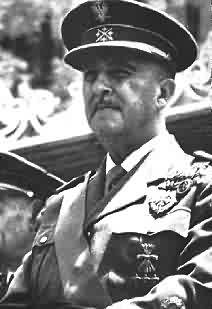
General Francisco Franco, victor in the Spanish civil war, albeit with significant German and Italian help. Although widely dismissed as a Fascist or a Nazi, he was in fact neither, merely an old style autocrat. Part Jewish, he refused to join Hitler during the Second World War, and was not averse to using Nonwhite troops if it suited him. His invasion of Spain, which started the Spanish Civil War, was launched from North Africa using Arab troops under his command. It was merely the anti-Communism of his political position and the possibility of a military exercise which persuaded Hitler and Mussolini to lend his forces assistance.
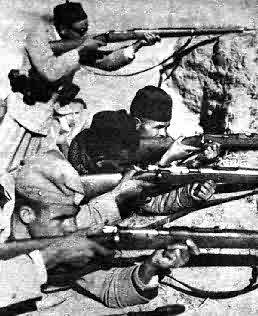
Above: A photograph of Nonwhite Moors (center) serving in Franco's army, here pictured at the battle of Navercaerno during the Civil War, 1936. Franco in fact launched his invasion of Republican Spain from a Spanish colony in North Africa, initially using virtually only Moorish troops such as these. Below: Communist Republican soldiers surrender to Franco's Nationalist soldiers during the Spanish civil war, 1936.
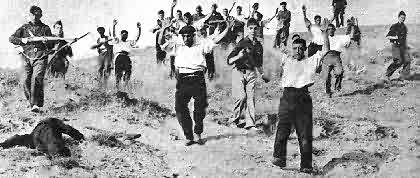
FRANCO USES MOORISH TROOPS
The second republic was however short lived. A military revolt in 1936 developed into a full scale civil war between supporters of the Republic - mostly Communists - and Spanish nationalists.
The Communists received material aid from the Communist International and material aid from the Soviet Union. In turn the nationalists received material aid from the leading anti-Communist powers of the time, Fascist Italy under Benito Mussolini and Nazi Germany under Adolf Hitler.
Finally as a direct result of German military intervention in the Spanish civil war, the Nationalists under general Francisco Franco overwhelmed the Communists. Due to the assistance given to Franco by Nazi Germany and Fascist Italy, Franco has long been classed as a fascist.
In fact he was neither a fascist or a Nazi. Part Jewish, Franco had initiated his attack on the Communist republic from across the Straits of Gilbratar with an army composed initially of Black Spanish soldiers, an indication of not only the racially integrated nature of Spanish society, but also of Franco's antipathy towards any racial politics.
For these reasons Franco refused to enter the Second World War on Hitler's side, as was widely expected, thereby keeping the Straits of Gilbratar open for the Allies, a move that was to prove crucial in the conduct of the war.
After the Second World War many countries associated Spain with the Nazis, and the Franco government went into a period of isolation. However, the growth of the conflict between the Soviet Union and the Capitalist west under the leadership of the United States (called the Cold War because it never broke out into a direct or "hot" war), Spain became regarded as an ally against Communism, and by 1955 the country's isolation had been broken and Spain was finally admitted to the United Nations.
Spain's history since then has been unremarkable: in 1975, Franco died and the country became a constitutional democratic monarchy in 1977. This did not satisfy the still independence minded Basques in the north of the country, some of whom continue to wage a violent guerrilla war, mostly without any political success.
CLICK HERE FOR PART II - THE STORY OF PORTUGAL
or back to
or
All material (c) copyright Ostara Publications, 1999.
Re-use for commercial purposes strictly forbidden.